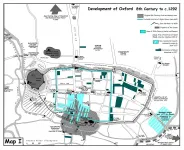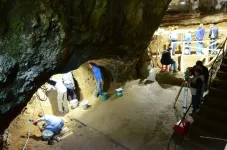(Press-News.org) Imagine the process of distributing electricity to homes from the power grid is like travelers boarding a train.
There are multiple steps to take before they can reach their final destination. First, they have to buy a ticket at the ticketing booth - this is where the power is generated. Then, they board a train that departs from the station - the power is transmitted over distances using transmission lines. Finally, the train takes the travelers (electricity) to their final destination. This final step of sending power to homes and businesses is called the distribution system - and it is critical that it remain reliable.
Chanan Singh and doctoral student Arun Karngala from the Department of Electrical and Computer Engineering at Texas A&M University, are working to develop a reliability framework for the distribution system so that utility companies can be better prepared for uncertainties that may arise. Singh is a Regents Professor, the Irma Runyon Chair Professor and University Distinguished Professor.
By developing these models and methods to perform the analysis of the distribution level of the power grid, adverse effects of localized weather events or equipment failure can potentially be prevented.
The researchers' framework can be also used to test the systemwide impact of installing rooftop solar and energy storage by the customers in the distribution system.
"We found that with 40% of customers installing solar capacity, that amounts to 1.5 times the peak demand of the respective households," Karngala said. "With sufficient energy storage systems, the reliability indices measured significant improvements. For example, the system average interruption frequency index was improved by 50%, the system average interruption duration index was improved by 70% and the customer average interruption duration index was improved by 45%."
Karngala said that this framework can also be used to decide the capacity of solar rooftop installation: "If the installed solar capacity is increased from one time the peak demand to two times the peak demand, the reliability indices show steady improvement. The improvement in indices tapers off after the installed solar capacity is increased more than 2.5 times the peak demand."
Performing reliability studies can help create business cases for purchasing such storage, and ongoing research on storage technologies is helping to provide more affordable and reliable alternatives.
The research team is focused on the analysis and reliability at the distribution level as it is the most vulnerable of all stages of power allocation and therefore can cause the most trouble for customers. Further, unlike high-level sectors of the power grid - such as power generation and transmission - that have existing methods of analysis and procedures to ensure that the reliability will be maintained in the presence of uncertainties at specified levels, the distribution level generally does not have such standards.
Most independent system operators (ISOs) ensure they have enough power generation reserve so that if an unexpected issue arises (e.g., transmission line failure, generator failure, the load being higher than forecasted, etc.) resulting in the total load not being supplied, the load can be adjusted so that it is not lost completely for all customers. Many ISOs use criteria that ensure that, on average, this load curtailment would not occur more than one day in 10 years. Such standards are not typically used at the distribution level.
This work was published in IEEE Transactions on Sustainable Energy in January.
"The winter storm event that happened recently in Texas was of a different nature that spanned the entire state," Singh said. "But extreme weather can be in a variety of forms. For example, you can have tornadoes or hurricanes where the effect is not statewide but instead more limited areas are affected. We believe that in those situations these models and the tools that they will provide to us to manage the system will enhance the reliability of the distribution system because you don't have to rely only on the power that is coming from the grid, but also from other local sources such as solar and perhaps wind."
One challenge that the team is facing is the many different kinds of generating systems being integrated into distribution systems that must be accounted for. Karngala said distribution systems previously were considered the only consumers of energy, but today there are newer technologies and many more distributed energy resources coming into the distribution system such as solar panels, wind generation and storage.
"The exciting part about working on distribution systems is that these are in a phase of change now," Karngala said. "These are changing from traditional systems to much more advanced systems, and we are in that transition phase where we need to develop models and methodologies."
Ultimately, the team is looking to build a comprehensive framework of reliability analysis where approaches such as demand response, price strategies and operational strategies can be included and be expanded upon as the power grid evolves.
"There is no shortage of projects that can be developed around this framework as many models, methods and operational strategies can be included in the reliability evaluation," Karngala said.
INFORMATION:
This work is funded by the Department of Energy as part of the U.S.-India Collaborative for Smart Distribution System with Storage project.
Today, the Muon g-2 Collaboration finally published the highly anticipated first result from its measurement of the anomalous magnetic moment of the muon, a precision quantity that offers physicists one of the most promising means to test predictions of the actual Standard Model of particle physics. The measured value, which is more precise than all values before, strengthens evidence for the emergence of new physics beyond the Standard Model, and thus for the existence of previously unknown particles or forces. The result was presented at an online ...
In a new study, North Carolina State University researchers found that an outdoor science program was linked to higher average science grades and an increase in a measure of science knowledge for a group of fifth grade girls in North Carolina.
The findings, published in the International Journal of Science Education, indicates outdoor education could be a promising tool to help close gender gaps in science.
"The outdoors is a space where teachers can find tangible ways to make science come alive," said the study's lead author Kathryn Stevenson, assistant professor of parks, recreation and tourism management at NC State. "The natural environment is also a place that everybody has in common. In a way, it's also a great context for employing reform-based teaching practices ...
Conspiracy theories appear to be increasing in popularity as the Covid-19 pandemic continues. But to what extent do people really agree with them, and what is the association with cognitive biases? A research team from the University of Basel studied these questions in German-speaking Switzerland and Germany.
Periods of crisis are often conducive to the emergence and spread of conspiracy theories, and the Covid-19 pandemic is a case in point. A research team led by Sarah Kuhn and Dr. Thea Zander-Schellenberg of the University of Basel has investigated the endorsement rates of coronavirus-related conspiracy theories in German-speaking Switzerland and Germany, ...
Muons, particles akin to electrons, have kepts physicists' heads spinning for more than a decade, because an experimental measurement of their magnetic properties (1) disagrees with theory. Could this be caused by unknown particles or forces?
A new theoretical calculation of this parameter, involving CNRS physicists and published in the journal Nature, has reduced the discrepancy with the experimental measurement. The debate nevertheless continues.
--
For over 10 years, measurement of the magnetic properties of the muon (an ephemeral cousin of the electron) has exhibited disagreement with theoretical predictions. This ...
A team of scientists, led by the University of Bristol, with archaeologists from Oxford Archaeology, have found the first evidence of a religious diet locked inside pottery fragments excavated from the early medieval Jewish community of Oxford.
Keeping kosher is one of the oldest known diets across the world and, for an observant Jew, maintaining these dietary laws (known as Kashruth) is a fundamental part of everyday life. It is a key part of what identifies them as Jews, both amongst their own communities and to the outside world.
Oxford's Jewish quarter was established around St. Aldates in the twelfth and thirteenth centuries, following William the Conqueror's invitation ...
Women are significantly underrepresented in the editorial boards of marketing academic journals, and awards and recognition favour men, new research from the University of Bath School of Management has found.
In their study 'It's hard to be what you can't see - gender representation in marketing's academic journals', Professor Andrea Prothero of Business and Society at University College Dublin and co-researcher Professor Pierre McDonagh examined gender representation in 20 marketing academic journals through three areas - the gender composition of editorial boards, special issue celebrations ...
Worldwide 39 percent of the adults were overweight in 2016, according to statistics of the World Health Organization. In the US the prevalence of obesity was 42.4 percent in 2017/2018, according to a survey of the National Center for Health Statistics (NCHS).
Concurrently millions of people want to lose weight. Physical exercise is an important option to achieve this. After all, more calories are consumed through sport than when sitting, standing or lying down.
But what influence does sport have on (direct) eating habits? Scientists at the Technical University of Munich (TUM) and the University of Nebraska (USA) have now investigated this ...
An international research team has sequenced the genomes of the oldest securely dated modern humans in Europe who lived around 45,000 years ago in Bacho Kiro Cave, Bulgaria. By comparing their genomes to the genomes of people who lived later in Europe and in Asia the researchers from the Max Planck Institute for Evolutionary Anthropology in Leipzig, Germany, show that this early human group in Europe contributed genes to later people, particularly present-day East Asians. The researchers also identified large stretches of Neandertal DNA in the genomes of the Bacho Kiro Cave people, showing that ...
Working safely is not only about processes, but context - understanding the work environment and circumstances, and being able to predict what other people will do next. A new system empowers robots with this level of context awareness, so they can work side-by-side with humans on assembly lines more efficiently and without unnecessary interruptions.
Instead of being able to only judge distance between itself and its human co-workers, the human-robot collaboration system can identify each worker it works with, as well as the person's skeleton model, which is an abstract of body volume, says Hongyi Liu, a researcher at KTH Royal Institute of Technology. Using this information, the context-aware robot system can recognize ...
3D-mammography reduces the number of breast cancer cases diagnosed in the period between routine screenings, when compared with traditional mammography, according to a large study from Lund University in Sweden. The results are published in the journal Radiology.
"Our results indicate that 3D-mammography, or digital breast tomosynthesis, possibly detects cancers that would otherwise have been diagnosed later at a more advanced stage", says Kristin Johnson, doctoral student at Lund University and radiology resident at Skåne University Hospital.
A large prospective screening study conducted at Skåne ...


